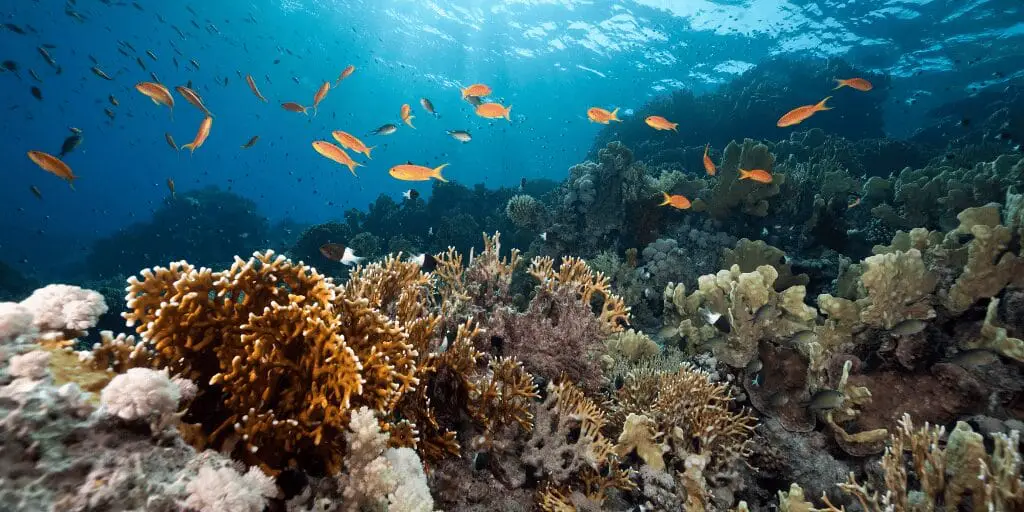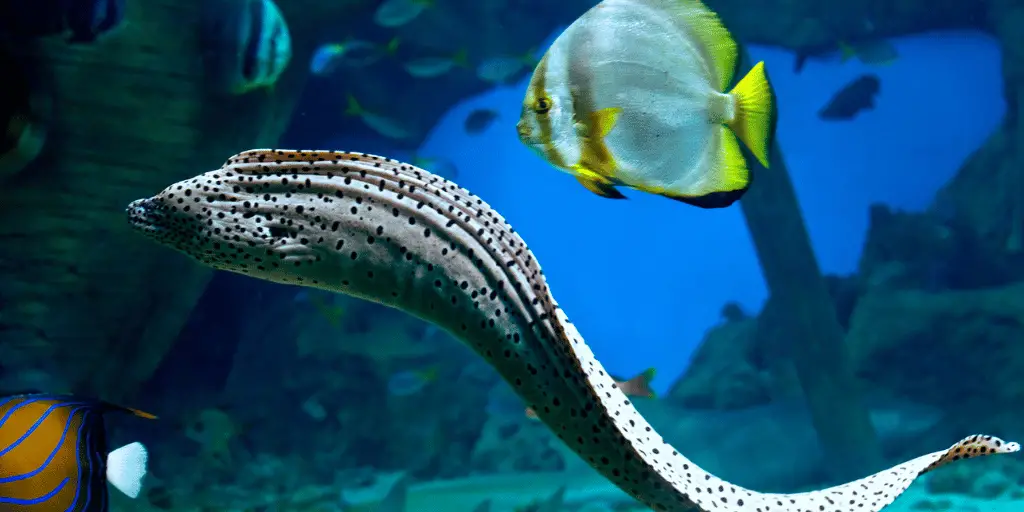Our planet’s oceans feel like another world. Vast areas remain unseen by humans, with crushing pressure and perpetual darkness. This isn’t a lifeless void – instead, the oceans overflow with incredible life, yet we’ve barely scratched the surface of understanding it.
Did you know that more people have traveled to space than to the deepest part of our oceans? The ocean’s depths are divided into unique zones, each more mysterious than the last. Sunlight fades, water temperature drops and bizarre creatures emerge, perfectly adapted to the extreme conditions.
Are you ready to dive into this strange and breathtaking world? We’ll travel from the familiar light of the surface to the pitch-black trenches. You’ll discover bioluminescent creatures, fish with monstrous fangs, and life teeming in places you never imagined possible.
The Sunlight Zone (Epipelagic Zone)

Imagine the ocean’s sun-drenched surface, extending down to approximately 200 meters – this is the epipelagic zone. Sunlight fuels this layer, driving an astonishing web of life. Let’s explore the key players and how they thrive in this unique environment:
The Foundation: Phytoplankton & Zooplankton
Microscopic phytoplankton harness the sun’s energy through photosynthesis, transforming sunlight into the fuel for the entire ecosystem. Zooplankton, tiny animals like copepods and krill, feast on the phytoplankton, forming the next link in the food chain.
Masters of Disguise: Jellyfish
Their translucent bodies make them experts at blending with the open water. Some jellyfish sting to catch prey, while others gracefully filter-feed on plankton.
Apex Predators: Sharks & Billfishes
Powerful bodies and incredible senses make sharks some of the ocean’s top hunters. Billfishes like marlin and swordfish use their elongated bills to stun and capture prey.
Ocean Wanderers: Seabirds
Albatrosses, gannets, and other seabirds soar above the waves, relying on the epipelagic zone’s bounty. They expertly snatch fish from the surface or plunge into the water to hunt.
These are just a few of the mesmerizing creatures thriving in this sunlit realm. Life here thrives on a delicate balance of predator and prey, where survival strategies range from camouflage and speed to teamwork and sheer power.
Want to delve deeper into the diverse inhabitants of ocean life in unique zones? Explore our guide: Animals in the Epipelagic Zone.
The Twilight Zone (Mesopelagic Zone)
Picture this: you’re diving deeper and deeper into the ocean. The sunlight slowly disappears, and a perpetual twilight sets in. Welcome to the mesopelagic zone, a strange world that stretches from roughly 200 to 1000 meters deep.
Survival gets tricky down here. There’s not enough sunlight for plants to grow, so food is scarce. That’s where things get creative, even a little scary! Animals get inventive to survive:
In this dim environment, a ton of creatures become their own flashlights. Bioluminescence is everywhere! Light lures prey, confuses predators, and helps attract mates. Imagine fish with glowing bellies or squid with flashing “headlights.”
With very little light, some creatures here have enormous eyes for catching that last glimmer. Others have tubular eyes pointing upward to spot bioluminescent flashes – think food falling from above!
Think crazy teeth, expandable stomachs, and lures on heads. When food is this hard to find, predators don’t mess around. They’re designed to grab and gulp whatever hapless creature swims by.
Intrigued by the inhabitants of this eerie zone? Prepare to be impressed:
- Lanternfish: These small fish might be the most common vertebrates on the planet! Their speckles of bioluminescence are like underwater constellations.
- Macrouridae (Grenadiers/Rattails): Slender fish with strangely pointed tails, they prowl the bottom searching for meals.
- Cranchiidae (Glass Squid): With see-through bodies for ultimate camouflage, they are ghostly masters of disguise.
The Twilight Zone is full of weird, wonderful creatures perfectly adapted to survive and rule this twilight realm of the ocean.
The Midnight Zone (Bathypelagic Zone)

Down here, between 1000 to 4000 meters deep, sunlight is long gone. It’s pitch-black, the water is near freezing, and the pressure is crushing. Yet, remarkably, life still exists! Welcome to the bathypelagic zone, one of the largest habitats on Earth and one of the least explored.
So, how does anything survive in this extreme environment? Adaptations become strange and clever:
- Living Lights: In a world without sunlight, bioluminescence is everything. Creatures use light to attract prey, distract predators, and even find mates in the inky blackness.
- Monsters of the Deep: Appearances get wild! There are fish with enormous mouths full of needle-like teeth to snag whatever drifts by or lures glowing like beacons on their heads to tempt prey.
In this pitch-black show, you’ll find:
- Eels: With snake-like bodies and eerie mouths, eels such as the gulper eel can expand their stomachs to swallow surprisingly large prey.
- Lanternfish: Survivors from the Twilight Zone, use their bioluminescent patterns to communicate and avoid predators.
- Anglerfish: The classic deep-sea nightmare! Their glowing lures tempt curious fish close to their terrifying teeth.
- Crabs: Even crustaceans exist here, scavenging dead creatures that slowly drift down into the darkness.
The Midnight Zone is a stark reminder of the ocean’s vastness and our limited understanding of it. Its inhabitants are masters of surviving in the harshest conditions imaginable.
Every discovery about this strange corner of the ocean offers a thrilling glimpse into the extraordinary resilience of life on our planet.
The Abyss (Abyssal Zone)
Down here, between 4000 and 6000 meters deep, the water pressure gets mind-boggling. It’s like weighting multiple jumbo jets pressing down on you! Yet, in this seemingly lifeless expanse, pockets of wonder exist.
Survival here requires more insane adaptations. Let’s look at abyssal inhabitants’ strategies:
- Coping with Pressure: Animals have specialized bodies that can handle the crushing pressure. Think soft, almost gelatinous flesh, flexible bones, and some with very little internal body fluids.
- The Leftovers: Food here relies on “marine snow” – bits of organic matter constantly raining down from the zones above. This means mainly scavengers and decomposers rule the seafloor.
- Hydrothermal Vents: The real ‘oasis’ of life in the abyss! Picture underwater hot springs erupting with mineral-rich water. Bacteria thrive on these chemicals, becoming the basis of an entire ecosystem of incredible creatures unlike anywhere else on Earth.
Meet a few residents of the deep:
- Molluscs & Echinoids: There are unique snails, clams, and even sea urchins adapted to abyssal life, slowly sifting through the sediment for whatever food they can find.
- Anglerfish: The glowing lure tactic still works down here! It’s all about snatching up a rare meal in the vast darkness.
- Octopi: Some octopus species, like the adorable Dumbo octopus with its ear-like fins, survive in this extreme environment.
Exploring the abyss feels like discovering a new world. It’s a harsh realm, dominated by creatures designed to survive under extreme conditions. If you want to delve further into these ocean oddities, check out our post: Animals that live in the abyssal zone.
The Trenches (Hadal Zone)

Stretching down as far as 11,000 meters (nearly 7 miles!), trenches are subject to the most unimaginable water pressure. To put it in perspective, it’s the equivalent of weighting 50 jumbo jets sitting on your finger!
The water is just above freezing, and darkness is absolute. It’s hard to imagine anything living down here, but incredibly, life persists.
So, how does anything survive? Think ultimate specialists:
- Pressure Pros: Animals here have uniquely adapted bodies to withstand the crushing pressure. Soft, almost jelly-like flesh and specially adapted proteins are key to survival.
- Bottom Feeders Rule: In this world, it’s all about eating whatever drifts your way! Scavengers and creatures that break down decomposing matter form the basis of trench life.
- Extremophile HQ: Some bacteria thrive in the harsh conditions around hydrothermal vents and seeps within trenches. These form the foundation for their own micro-ecosystems!
Here are some deep-sea stars:
- Snailfish: The deepest-dwelling fish we know of, their transparent bodies and flexible bones help them cope with the pressure.
- Cusk-eels: Related to snailfish, these elongated fish have similar squishy bodies to withstand the depths.
- Grenadiers: Another family of deep-sea dwellers, grenadiers use their strong sense of smell to find food in the darkness.
- Giant Amphipods: Look like oversized versions of backyard pillbugs! These scavengers play a vital role in cleaning up the deep ocean floor.
Exploring trenches reveals amazing adaptations that allow life to exist against all odds. Want to go deeper into this extreme underworld? Dive into these posts: Animals that Live in the Mariana Trench and Animals in the Hadal Zone.
Mysteries & Discoveries: Unique Wonders like the Great Blue Hole
Think of the Great Blue Hole – Belize’s largest sinkhole. Plunging over 300 meters deep, it has everything from stalactites (think cave formations, but underwater!) to unique marine life like sharks and mysterious midnight parrotfish.
There are similar marvels scattered across the ocean floor, each creating a microenvironment within the ocean itself. These oddities offer pockets of unusual conditions for specialized creatures to thrive.
So, who calls this amazing place home? Here’s a sneak peek:
- Midnight Parrotfish: Named for their dark coloration, these unique fish find shelter in the Blue Hole’s depths.
- Caribbean Reef Sharks, Bull Sharks, and Blacktip Sharks: These powerful predators roam the diverse zones within the sinkhole.
- Sea Turtles: These ancient mariners grace the waters around the Blue Hole
- Mollusks, Echinoderms, & Algae: A whole range of smaller creatures and plant life fill out the lower rungs of this vibrant ecosystem.
Want to know about the creatures that call the Great Blue Hole home? Check out our guide: Animals in the Great Blue Hole.
The most exciting thing is, most of the ocean remains unexplored. Scientists are continually making thrilling discoveries – new species, weird geological features, and maybe even hints about how life on Earth began!
Just when you think you’ve seen it all, the ocean throws something completely new our way. It’s a reminder that there’s a whole other world down there, teeming with secrets waiting to be revealed.
Final Thought on Ocean Life in Unique Zones
From the sparkling, sunlit surface to the crushing depths of ocean trenches, our journey has uncovered a breathtaking array of life.
Tiny plankton forming the base of the food chain, bioluminescent creatures creating their light shows, monstrous predators, and extremophiles thriving against all odds – the ocean proves time and again that life finds a way, even in the strangest places.
These underwater ecosystems aren’t just fascinating to explore; they’re vital to our planet’s health. The ocean feeds us, regulates our climate, and hosts a mind-boggling level of biodiversity.
Yet, pollution, overfishing, and climate change threaten this extraordinary underwater world. It’s up to us to understand the ocean and the crucial role it plays in supporting life on Earth and to act as protectors of this precious wilderness.

